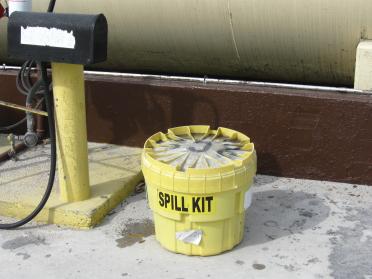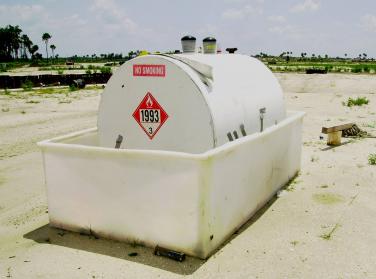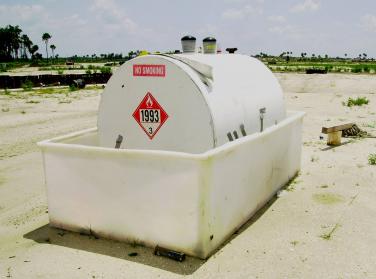


This article is the second of a three-part series. Look for the third installment in mid-October.
By Jo Moore, Environmental Director for Ranger Construction Industries, Inc; member of AGC’s Environmental Forum Steering Committee
If you have oil on your jobsite, or at your asphalt plant, be aware of the Nov. 10, 2011, deadline to comply with the U.S. Environmental Protection Agency’s (EPA) oil spill planning rule. The federal Spill Prevention Control and Countermeasure (SPCC) program applies to the owner and operator of any facility or construction site that has the “capacity” to store more than 1,320 gallons of any type of oil product in above ground storage tanks/containers. This is Part 2 of a three-part series intended to help AGC members determine if they need a federally-required oil spill plan – and, if they do, the series will help them develop one that meets EPA requirements.
The main goal of the SPCC program is to prevent oil from entering surface waters or nearby shorelines of the United States. The rule applies in all 50 states and is administered and enforced by federal EPA in every state; however, states and localities also may have supplemental oil programs. Inspectors are looking for sheens on water, the ground, or pavement, oil storage containers without secondary containment or with improperly sized secondary containment, lack of alarm systems to notify personnel of spills, missing records and failure to train personnel. This rule is in addition to any oil spill requirements required by your stormwater pollution prevention plan.
As discussed in Part 1 of this series, EPA has provided an “SPCC Plan Template” (hereinafter EPA template) for use by so-called “Tier I facilities” (e.g., a construction site that’s regulated by the SPCC rule and that stores limited quantities of oil and has no history of oil spills – see below). Construction companies that are eligible to use the EPA template will find that it is the most simple and cost effective means of achieving compliance. A full-blown, PE-certified SPCC plan can cost from $2,000.00 to $4,000.00, depending on your geographical area and the complexity required. With the template, you will be able to establish a “standard” of practices that will be useful on most projects. Template users can then simply adjust the storage capacities, “at risk waters” and the required maps and drawings for each individual project. Construction companies that have storage yards with fuel tanks or shop facilities meeting the Tier I criteria will also be able to use the EPA template to develop SPCC Plans for those facilities as well.
Can You Use the SPCC Plan Template on Your Jobsite?
If you are regulated by the SPCC rule, you may use EPA’s template, if your facility or jobsite meets the following criteria:
1. a total aboveground oil storage capacity of 10,000 U.S. gallons or less (count containers 55 gal and up);
2. no aboveground oil storage containers with a capacity greater than 5,000 U.S. gallons; and
3. in the three (3) years prior to the date the SPCC Plan is certified, had no single discharge of oil to navigable waters or adjoining shorelines exceeding 1,000 U.S. gallons, or no two discharges of oil to navigable waters or adjoining shorelines each exceeding 42 U.S. gallons within any 12-month period.
Developing Your Plan Using EPA’s Template: The Basics
Go online to access EPA’s SPCC Plan Template and complete Sections I, II and III as directed by the instructions. Section A for Onshore Facilities (Table G-10) will also apply. Include the appropriate attachments for maps, reviews, inspections, training logs, etc. You may choose to modify the EPA template to meet your own specific needs, BUT NOTE that if you customize any of EPA’s forms, you must provide a reference document that cross-references all appropriate sections of your form to the template and/or rule. If you have questions, the EPA’s SPCC Guidance for Regional Inspectors is a good document to use for additional information as to the meaning of specific sections and to review the EPA’s opinion as to the meaning of various sections.
Some typical types of containers and oil found on construction sites would include bulk fuel tanks, maintenance oils, form oils, fuel tanks connected to pumps or generators and oil filled equipment such as transformers. SPCC will apply to a construction site until such time as the contractor has completed his work and/or removed the oil storage systems from the site. Remember to obtain information from any subcontractors who may bring containers to the site and assure that they understand the requirements of your SPCC plan. Changes to the plan must be made within six (6) months of the occurrence requiring the change.
After completing all appropriate sections of your SPCC Plan, it must be signed and certified by a corporate officer, partner or business owner. Remember that certification statements carry “penalty of law” in that you can be charged (fines and / or jail time) if you make false statements. Be certain to conduct inspections and tests in accordance with your written procedures and keep your records for a period of three (3) years. Incorporating these records into your project records should provide sufficient protection for the record keeping duration requirement since most contractors keep project records far longer than three years.
The regulations require a formal five (5)-year review and recertification. Since some projects last less than five years, it would be wise to have each project plan certified and establish a recertification schedule for those lasting longer than five years.
The written plan must be kept at the facility (or site) if it is “manned” four (4) or more hours per day. If staffed less than four hours per day, then keep the plan at the closest field office.
A Closer Look at Using EPA’s Template
The primary segments of EPA’s SPCC Plan Template including the following:
[[{"type":"media","view_mode":"media_large","fid":"4559","attributes":{"class":"media-image size-thumbnail wp-image-10529 alignright","typeof":"foaf:Image","style":"","width":"150","height":"150","alt":""}}]]
1. Oil storage containers: list a reference number for the storage unit, size and type of oil and above- or below-ground tank location.
2. Secondary containment: describe the secondary containment and/or diversionary equipment that will be utilized. Identify tanks and containers with a potential for oil discharge, how they may fail, direction of oil flow and potential quantity of discharge along with secondary containment method and containment capacity.
3. Describe inspection procedures, frequency, method of testing (if a specific industry standard is utilized) for tanks and piping at the site. Make a written report signed by the person conducting the inspection. If your site has an NPDES (stormwater) permit, you can combine the two inspections into one report. The only challenge for this is when using owner-required inspection forms which could be handled by providing an attachment. In reality, inspection of oil storage areas is a normal part of an NPDES inspection, but most owner-provided forms do not reference this type of activity nor provide appropriate space for it.
4. Assure that personnel handling oil are properly trained and training records are kept. This should be done annually. Include past discharges or incidents as a means of additional instruction and any recently developed precautionary measures that may have been added to the plan since the last briefing.
5. Describe security measures used to control access to oil storage and handling areas. Describe how you will prevent unauthorized access to starter controls on oil pumps, loading and unloading connections and to prevent acts of vandalism. Site lighting and fencing are components of security that should be included.[[{"type":"media","view_mode":"media_large","fid":"4560","attributes":{"class":"media-image size-thumbnail wp-image-10500 alignright","typeof":"foaf:Image","style":"","width":"150","height":"150","alt":""}}]]
6. Discuss emergency procedures to be taken in the event of a spill as well as additional measures to be employed if a spill reaches navigable waters. Also discuss the appropriate notifications that are to be made and include a list or notification “tree” (calling priority) for the facility or site. Include the National Response Center (NRC) and any State Response Center in your notifications per state or local requirements.
7. Identify a list of response contractors that can be contacted in the event of a spill. They should have 24-hour contact numbers and these should be easy for your site personnel to find. Site-specific personnel should also be listed with their 24-hour contact numbers. Some sites will have additional requirements for contacting owner personnel and their contact information should be listed here also. If 911 is not the emergency response number for the fire department, list it here as well. The name of the closest hospital and phone number also should be included. If there are other entities that may receive an immediate threat due to a release from your site (e.g., gasoline spill near a day care center), you should include their information here and direct your staff to notify them as soon as possible after other appropriate notifications are made.
8. It is a good idea to develop a format for your staff to use in reporting an incident. The Tier I template identifies information that is to be provided to the NRC. Having a format to use will help assure appropriate communication reaches all necessary parties.
a. Section A is to be completed using Table G-10 and indicating if the element in the chart is included in your plan, or select N/A to indicate that it is not.
9. Attachment 1.1 provides a log for the Five (5)-Year Review and Recertification.
10. Attachment 1.2 provides a log of Technical Amendments. The actual amendment should be placed in the proper section of the plan, with a reference to it placed here along with the date.
11. Attachment 2: Oil Spill Plan and Contingency Checklist would only be used in some circumstances where a site has oil-filled equipment (such as a transformer or generator) at the site.
12. Attachment 3.1 Inspection Log can be used to document inspections, or refer to a separate inspection form developed for use by your company in lieu of this form. Include date, general observations of the condition of equipment (tanks, piping, hoses and containment – also see below), any minor spills that are located and cleaned up and the signature of the inspector.
13. Attachment 3.2 Bulk Container Inspection Log provides information on elements to be included in an inspection of bulk containers. This information can be combined with other SPCC inspection logs to create a general inspection log on one form.
14. Attachment 3.3 Dike Drainage Log provides for recordkeeping of the times stormwater is removed from the secondary containment, condition of the water and signature of the inspector who supervised the drainage. Also record that any drains have been closed and locked. This information may also be included in a general inspection log on one form.
15. Attachment 3.4 Oil Handling Personnel Training and Briefing Log provides for recordkeeping of training conducted. For some companies, this form would not provide enough space to describe the training provided and the number of attendees with signatures. You may refer to other documents in this log.
16. Attachment 4 Discharge Notification Form provides the information required to be given to the NRC in the event of a discharge. It would be helpful to already have this information filled out prior to making the phone call. Also record the time and date of the call as well as the name of the person spoken to (who received the call). Additional forms may be required by other agencies.
17. Maps: You will need a general area map (USGS), a site specific map or drawing (site plan) indicating where oil storage and handling activities take place and perhaps a detail of any containment areas that may be constructed on site. Indicate the location of water bodies and the path that a spill may be expected to take along with the locations of any prevention or diversion devices that have been installed. Click here to see example maps, for your reference.
Spill Prevention Tips for Contractors
Some practical considerations for spill prevention on construction sites include the following:
1. When possible, do not store tanks or other oil sources near water bodies, storm drains, ditches or channels that can carry oil to a water body.
2. Evaluate the potential for run-in damage and take precautions to prevent this from occurring.
3. Maintain supplies of cleanup materials (absorbents, etc) close to areas where fuel transfers take place.
4. Assure that all personnel who transfer fluids follow procedures, use drip pans under connection points and possibly also use tarps to prevent drips from oil changes or other equipment maintenance activities from contacting the soil.
5. General housekeeping and maintenance should apply to fuel tanks as well. Keep tanks in good condition by preventing corrosion, and inspect hoses and nozzles for cracks and leaking gaskets.
6. Secondary containment that has a drain(s) must be kept “normally closed” and preferably locked. Do not let anyone remove a drain plug and walk away from the tank as it is too easy to forget to replace it. Collected stormwater must be free of sheen prior to discharge from secondary containment.
7. Double wall tanks are preferable to using secondary containment on sites as they alleviate the need for dealing with collected stormwater removal. Manufacturers are making more of these now than in the past (250 – 1,000 gallon size).
8. Inspections should include some daily awareness for those accessing fueling/oil storage areas on a regular basis. A written weekly inspection should be conducted in those areas most likely to receive spills/contamination. On a monthly basis, take a closer look at hoses, connections, spill prevention structures, etc. to assure all equipment is in good working order. Include an evaluation of the spill kits to assure adequate supplies are on hand. Mobile service units should also carry spill cleanup supplies sufficient to deal with a discharge from their unit.
9. If inspections are not performed by someone with the supervisory authority to direct corrective action, then they should at least be reviewed and secondarily signed by such a person.
10. Training necessary for SPCC compliance can be incorporated into the regular tool box safety meetings, if your company conducts them. If not, then you must assure that those handling oil receive separate adequate training.
At our company, one of the directives we receive is “Do The Right Thing”. Environmental compliance can be a challenge to weave into the culture of a company, but in reality, it is not any different than improving the safety culture of a company. The cost of clean-up of a small spill of 25 gallons can start at $5,000.00 by the time you use a response company and complete the documentation required to prove the removal of contamination. It is much more cost effective and environmentally responsible to prevent spills than deal with a cleanup. An SPCC Plan will help you prevent spills as well as plan what to do in advance so you can respond quickly and effectively to minimize both damage and cost should a spill occur.
Jo Moore is the Environmental Director for Ranger Construction Industries, Inc. Ranger is a heavy and highway contractor and asphalt paving materials producer with operations throughout central and south Florida. Building on her more than 30 years of construction industry experience, Jo developed and implemented Ranger’s environmental compliance and training program over the past 14 years. She is a Florida Department of Environmental Protection (FDEP) Qualified Stormwater Inspector as well as being a Qualified Instructor for FDEP’s Inspector Training Program. She presents educational seminars to other contractors through the local AGC Chapter as well as providing presentations for various professional and industry associations.